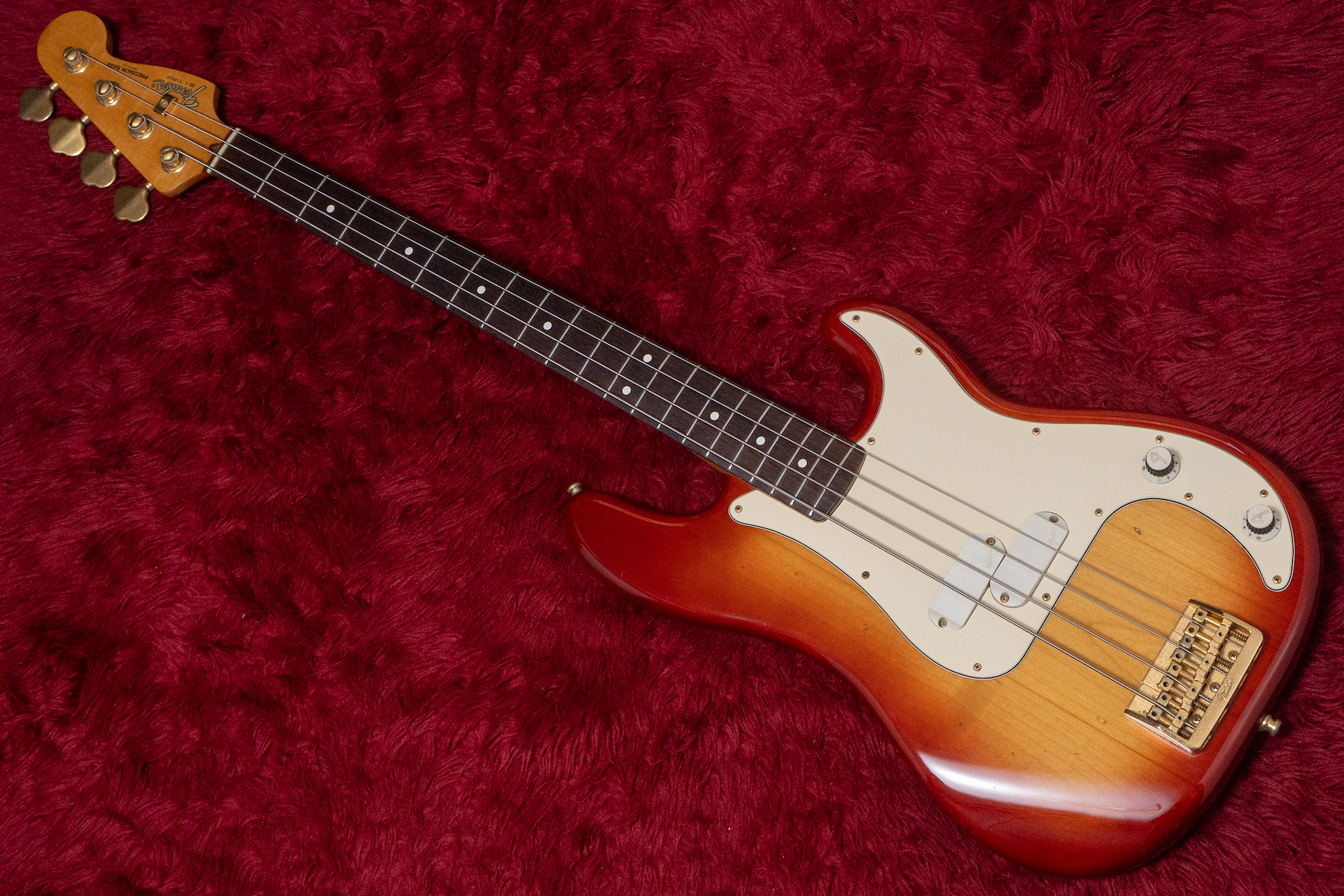- I. Introduction: The Premium Model of the 1980s, the Fender Gold Elite Precision Bass
- II. Fender Elite Series: Background and Evolution
- III. Fender Gold Elite Precision Bass I: Specifications and Features
- IV. Fender Gold Elite Precision Bass II: Specifications and Features
- V. Design Innovations and Unique Features of the Elite Series
- VI. Available Finishes and Options for the Gold Elite Model
- VII. Sound Characteristics and Playability Based on Reviews
- VIII. Market Value and Collector’s Item Aspect of the Fender Gold Elite Precision Bass
- IX. Conclusion: The Enduring Appeal of the Fender Gold Elite Precision Bass
I. Introduction: The Premium Model of the 1980s, the Fender Gold Elite Precision Bass

Fender’s Elite series debuted in 1983 as a line of “premium” models. It was positioned above the standard series at the time, alongside vintage reissue models . Among this series, the Gold Elite Precision Bass is a special model characterized by its gold-colored hardware . The Elite series was produced from 1983 to early 1985 .
In the 1980s, Fender aimed to provide modern instruments by incorporating new technology while adhering to traditional designs . The Elite series perfectly embodies this attempt, featuring innovative functions such as active electronics. The name “Gold Elite” was likely used within the Elite series to distinguish models with gold hardware from those with chrome hardware . It was not just a model name but a designation indicating specific specifications.
II. Fender Elite Series: Background and Evolution
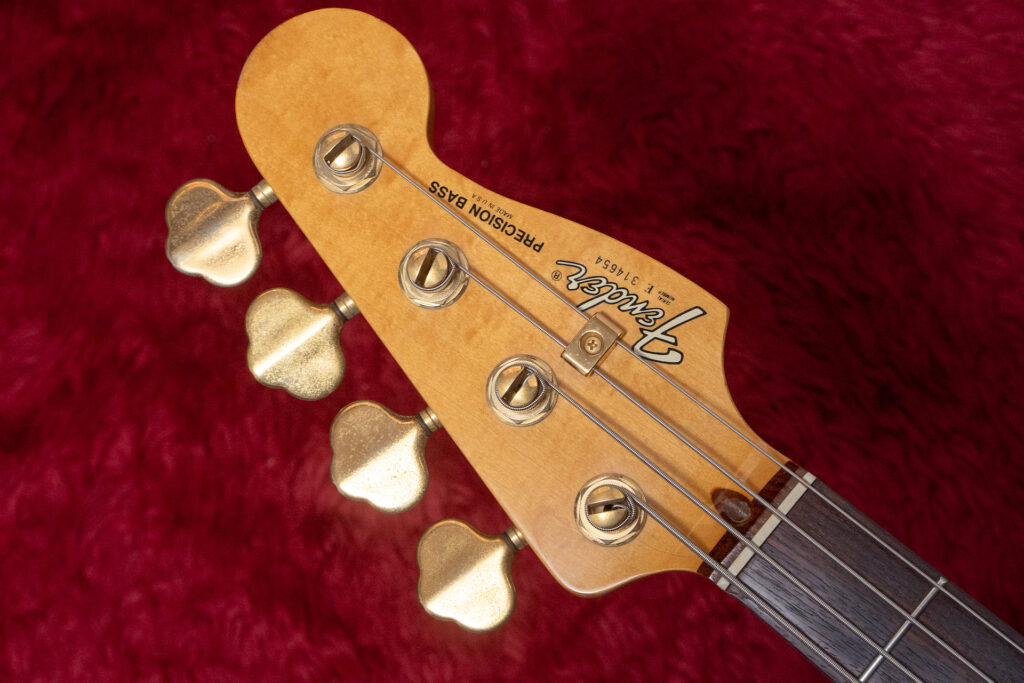
Before the introduction of the Elite series, “Special” models existed in the early 1980s . The Elite series was developed as the successor to these Special models, with the aim of pursuing more sophisticated technology and design. Its design philosophy was to evolve Fender’s existing designs with new technology while preserving their classic appeal as much as possible .
There are two main models in the Precision Bass Elite series: the Elite I, equipped with a single pickup, and the Elite II, equipped with dual pickups . These models each had different characteristics and were designed to accommodate a variety of playing styles and musical genres.
Fender’s Elite series can be seen as a precursor to the “Deluxe” models that would later appear . This suggests Fender’s continuous effort to always offer higher-end models in its product lineup. Over the years, Fender has added various variations to its representative instruments to meet the needs of the times. The Elite series was an important step in this evolutionary process.
III. Fender Gold Elite Precision Bass I: Specifications and Features
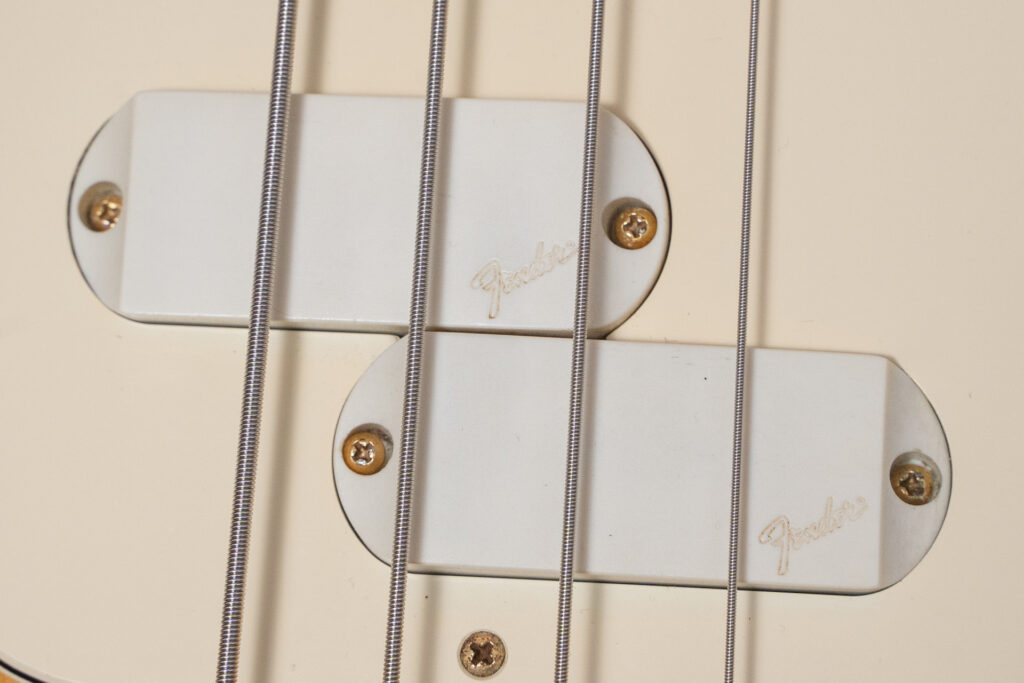
A. Body:
The body material of the Gold Elite Precision Bass I was generally alder . However, some early models may have used walnut . The body finish used a durable polyester coating .
B. Neck:
The neck was made of maple and featured a “modern oval C” shape . Early models also seemed to have a walnut neck with an ebony fingerboard . The fingerboard was maple with black dot inlays . A rosewood fingerboard was also available as an option . It had 20 medium jumbo frets . The scale length was 34 inches, and the nut width was 1.75 inches . The truss rod could be adjusted from the headstock side and used Fender’s newly developed Biflex system, allowing adjustment for both convex and concave neck warpage . The neck joint was secured with four bolts and featured a micro-tilt function for fine-tuning the neck angle .
C. Hardware (Gold):
The tuning machines were gold-finished die-cast Fender/Schaller made and were highly regarded for their responsiveness . The bridge was a gold-finished high-mass type with individually adjustable saddles and fine tuners . However, many models found on the used market are missing the fine-tuner knobs . The control knobs were a unique “F” logo design with rubber grips in gold color, specific to the Elite series . The string tree was also a gold-colored round type . Additionally, strap locks were included from the factory .
D. Electronics:
The pickup was a single Elite split-coil P pickup with noise-canceling, designed by Paul Gagon . It had a built-in active preamp powered by a 9V battery . The tone control featured a center-detent TBX (Tone Boost Expansion) control . Turning it clockwise boosted the mid-high frequencies, while turning it counterclockwise cut the high frequencies. A master volume control was also included . The jack socket was a side-mounted type embedded in the body . The pickguard was a multi-layered white color .
The inclusion of active electronics and the TBX tone control allowed the Precision Bass to achieve a wider range of sounds beyond the traditional passive tones . The active preamp’s treble and bass boost functions, along with the TBX control’s mid-high boost, provided a variety of sounds not obtainable with the simple volume and tone controls of a traditional Precision Bass. This reflects Fender’s pursuit of a more versatile instrument to cater to a broader range of musical genres.
The innovative high-mass bridge with fine tuners offered advanced functionality, but the fact that fine-tuner knobs are often missing in the used market suggests potential design issues or user preferences may have played a role. The frequent loss of fine-tuner knobs might indicate some challenges regarding the durability or usability of this bridge. This is a point to consider when considering a purchase.
IV. Fender Gold Elite Precision Bass II: Specifications and Features
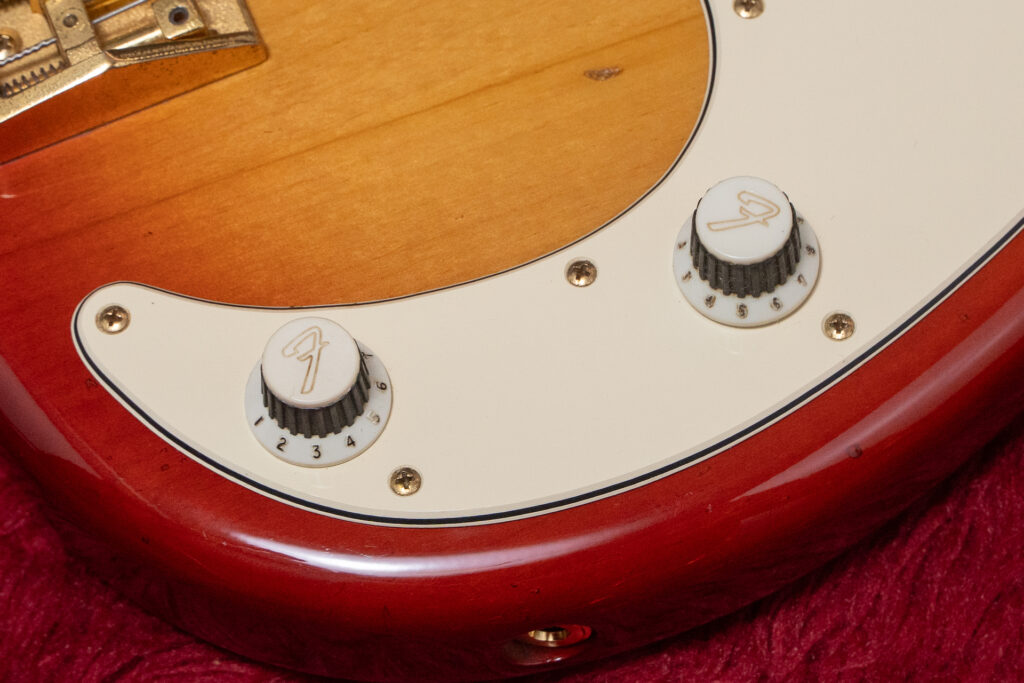
A. Body:
The body material of the Gold Elite Precision Bass II was also alder, similar to the Elite I . The finish was polyester .
B. Neck:
The neck was made of maple with a “modern C” shape, which is praised for being thin and comfortable . The fingerboard was available in maple or rosewood with dot inlays . It had 20 medium jumbo frets . The scale length was 34 inches, and the nut width was 1.75 inches . The Biflex truss rod system and micro-tilt neck adjustment mechanism were included, just like the Elite I .
C. Hardware (Gold):
The tuning machines were gold-finished Schaller made . The bridge was a gold-finished high-mass type with adjustable saddles and fine tuners . The control knobs were gold-colored “F” logo knobs with rubber grips . The headstock had a single gold-colored circular string guide . Strap locks were also standard equipment .
D. Electronics:
The pickups were two Elite single-coil P pickups with noise-canceling, designed by Paul Gagon (one in the neck position and one in the bridge position) . It had a built-in active preamp powered by a 9V battery . Unlike the TBX control of the Elite I, the tone control was a standard passive tone control . Each pickup had an independent volume control . It also featured a 3-way toggle pickup selector switch . Furthermore, there was a 3-way toggle switch called a tone assignment switch, which allowed the master tone control to be assigned to either one or both pickups . The jack socket was a side-mounted type embedded in the body . The pickguard was a multi-layered white color .
The dual-pickup configuration and the tone assignment switch gave the Elite II a wider range of tonal variations compared to the single-pickup Elite I . By blending the two pickups and switching the effect of the tone control, it was possible to create diverse sounds, making it an attractive model for players seeking more flexible tone shaping.
However, the control layout of the Elite II, especially the tone assignment switch, was considered “strange” and difficult to understand by some users . This suggests that players accustomed to the controls of a traditional Precision Bass might need some time to get used to it. Players who prioritize intuitive operation should be aware of this point.
V. Design Innovations and Unique Features of the Elite Series

A. Biflex Truss Rod System: This system allows the neck to be adjusted not only for convex warpage but also for concave warpage, accommodating various string gauges and action preferences .
B. Micro-Tilt Neck Adjustment: By incorporating a micro-tilt mechanism into the 4-bolt neck joint, the neck angle could be precisely adjusted without the use of shims, offering improved stability compared to the traditional 3-bolt system .
C. High-Mass Bridge with Fine Tuners: The heavy gold-colored bridge featured individual saddles for each string, allowing for precise adjustment of string height and intonation, as well as fine tuners for minute pitch adjustments . However, as mentioned earlier, it’s important to note that the fine-tuner knobs are often missing.
D. Unique Pickup Covers and Knobs: The white pickup covers with a unique shape specific to the Elite series and the “F” logo knobs with rubber grips were significant visual features that differentiated it from other Fender basses .
E. Recessed Jack Socket: The jack socket embedded in the side of the body contributed to a cleaner appearance .
F. Strap Locks: The inclusion of strap locks as standard equipment from the factory was a welcome feature for professional musicians .
The Elite series incorporated many advanced design elements not common in Fender basses of the time, showcasing an attempt to fuse traditional style with modern functionality . The Biflex truss rod, micro-tilt adjustment, active electronics, and high-mass bridge were relatively innovative features for early 1980s Fender, indicating an intention to cater to players seeking modern bass sounds and playability.
VI. Available Finishes and Options for the Gold Elite Model
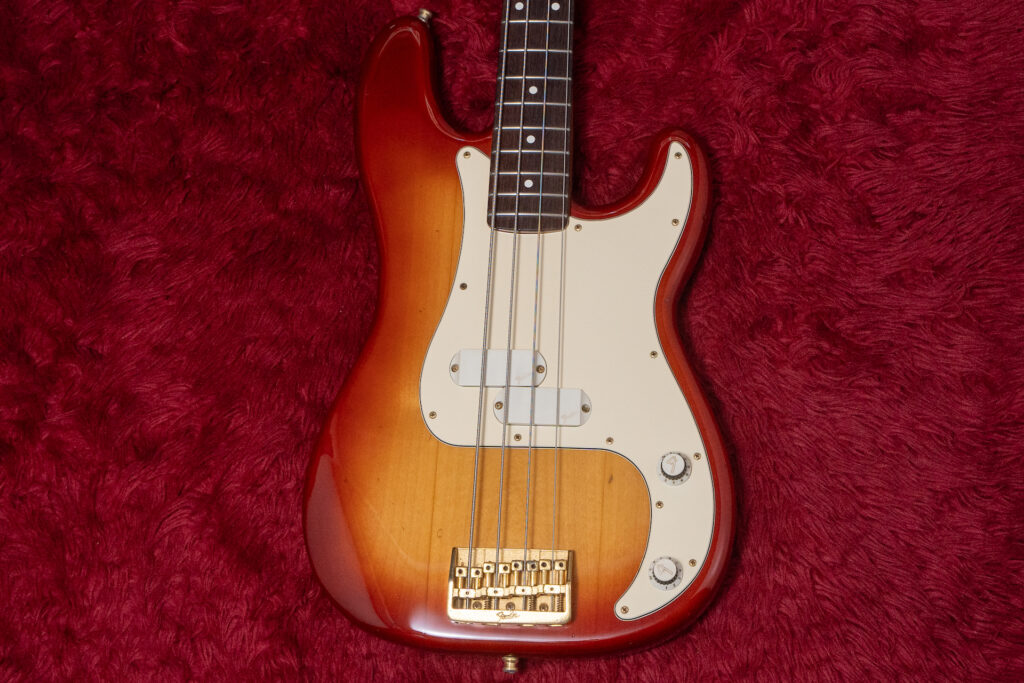
The standard colors for the Elite Precision Bass series, which were generally paired with gold hardware, included:
Black
Natural
3-Color Sunburst
Sienna Sunburst
Brown Sunburst
Pewter
Arctic White
Aztec Gold
Custom color options were also available, with some featuring gold hardware:
Candy Apple Red
Lake Placid Blue
Candy Apple Green
Transparent Emerald Green
Wild Cherry
Stratoburst Finishes (Black, Blue, and Bronze)
Fingerboard options included maple and rosewood .
Thus, the Elite series offered a wide range of finish options in addition to the standard Precision Bass colors, allowing players to choose a look that suited their preferences . The diverse color variations, including metallic colors and burst finishes that reflected the trends of the 1980s music scene, were likely a significant attraction for players.
VII. Sound Characteristics and Playability Based on Reviews

A. Elite I:
It is described as having a deep, clear sound with good sustain, and the active electronics and TBX control add versatility to the traditional Fender P-Bass tone . However, some reviews note a lack of “hardness in the low end” and “warmth in the overall tone spectrum” compared to a regular passive P-Bass . The neck profile is considered thin and comfortable .
B. Elite II:
It is praised for providing a modern and versatile P-Bass tone due to its dual pickups and active preamp . It is particularly noted for its suitability for slap playing due to its tone, string tension, and string spacing . However, some opinions suggest it lacks the deep bass and punchy low-midrange of a traditional workhorse bass . The neck is characterized by being very thin front-to-back with a wide nut width, which may be a matter of personal preference for players . The active preamp allows for a wide range of tones, from bright to deep .
The sound of the Gold Elite Precision Bass was modern and versatile due to its active electronics, but it might not completely replicate the traditional warmth and punch of a vintage passive Precision Bass . While the tonal expandability offered by the active circuitry is appealing, players seeking the classic P-Bass sound might find this aspect lacking.
The neck profile of the Elite series, particularly its wide and thin shape, is a significant characteristic of this bass. While it may be very attractive to some players, others might find it difficult to handle . Since the neck shape greatly affects playability, it is important to try it out to see if it fits your hand.
VIII. Market Value and Collector’s Item Aspect of the Fender Gold Elite Precision Bass
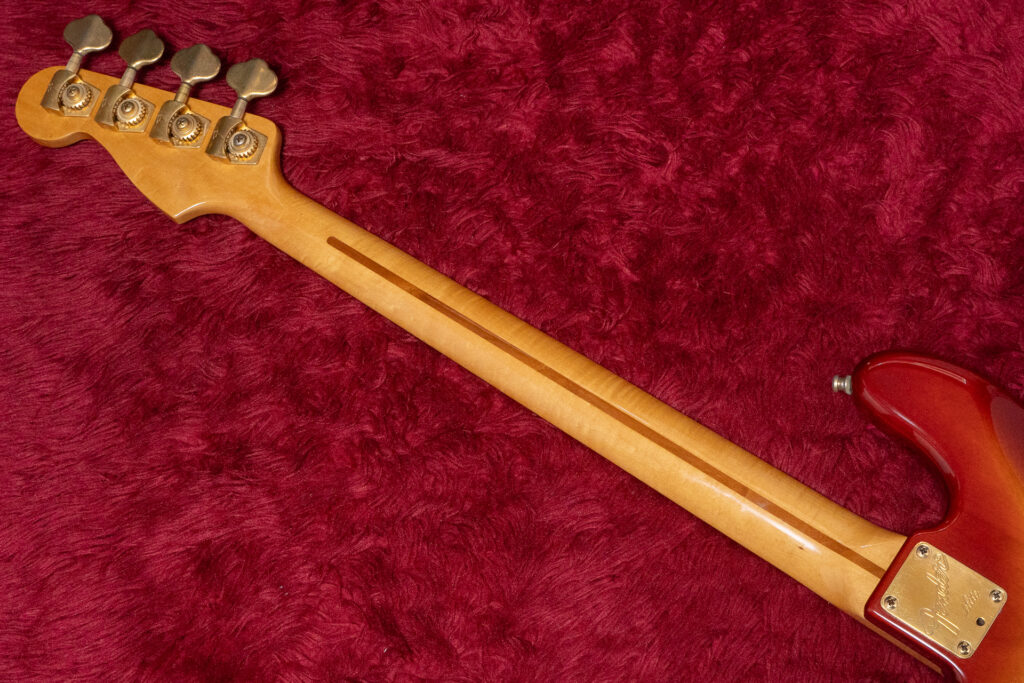
According to the provided information, the current market value of a used Gold Elite Precision Bass I ranges from approximately $1,200 to $1,700 . A specific listing shows a price of $1,699 .
The used market value of a Gold Elite Precision Bass II varies from around $2,179 to $4,481.14 , with one estimate around $2,200 . Listings show prices of $3,165.16 for a model in mint condition and $4,000 to $4,481.14 for models in very good to excellent condition .
Factors influencing the price include the instrument’s condition, the presence of original parts (especially the fine-tuner knobs on the bridge), and the rarity of specific finishes. Although it is a relatively rare model, its value has not soared as high as pre-CBS vintage Fenders .
The price range of the Gold Elite Precision Bass suggests that while these instruments hold value as collector’s items, they are not as expensive as highly sought-after vintage Fender basses from the 1950s and 1960s . Therefore, they can be an attractive option for players looking for a unique, high-quality instrument with a vintage feel as an alternative to very expensive vintage instruments.
IX. Conclusion: The Enduring Appeal of the Fender Gold Elite Precision Bass
The Fender Gold Elite Precision Bass series (both I and II models) emerged in the 1980s as premium instruments that blended classic design with modern features. They incorporated innovative features for Fender at the time, such as active electronics, a Biflex truss rod system, micro-tilt neck adjustment, and a high-mass bridge. While the sound was modern and versatile, it had different characteristics compared to the warmth and punch of a traditional passive Precision Bass. The neck profile, characterized by its wide and thin shape, is a point that may vary in player preference.
In terms of market value, they are not as expensive as vintage pre-CBS Fenders, but their value as collector’s items is recognized. Therefore, they can be an attractive option for players looking for a unique Fender bass at a relatively affordable price.
The Fender Elite series, especially the Gold Elite Precision Bass, is an interesting model in Fender’s history, symbolizing an experimental and innovative era. The attempts at modernization during this period were an important step in the development of subsequent Fender models that incorporated modern features such as active electronics.

